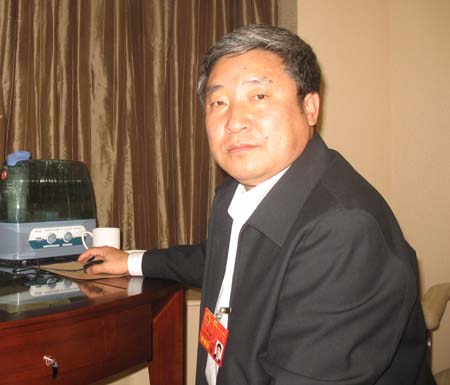In 1994, Lester R. Brown, head of the US Worldwatch Institute, challenged China's food prospects in his book Who Will Feed China? He predicted that China's inability to feed its huge population would come to pose a major threat to the world.
After decades of work, however, a group of Chinese scientists have shown this fear to be imaginary. The super rice they developed produces a super-high output.
Chen Wenfu is one of the scientists. The rice he developed sees a per-mu (15 mu=1 hectare) yield of 800-plus kilograms in the laboratory and a per-mu yield of 700-odd kilograms on ordinary farmland.

Chen Wenfu
Famous worldwide among his peers, the scientist is relatively unknown in his homeland. Now a deputy to 11th National People's Congress (NPC), Mr. Chen Wenfu, who is also a professor at Shenyang Agricultural University, gave an exclusive interview to China.org.cn.
"The most notable feature of super rice, of course, is its super high yield," Professor Chen said. "China is home to 1.3 billion people and its farming lands, sadly, are quite limited. To ensure the country's food security, it is of great importance to increase the per-unit output of grains."
"Another feature of super rice is its resistance to plant disease and insect pest, which is key to ensuring stable output. A high-yielding but fragile rice means nothing in real production," said the scientist. "The third feature of our super rice is its good quality, which now meets National Grade II Standard."
Super rice boasts an extra high yield, but the amount varies in different regions because rice is quite sensitive to sunshine and temperature. Cultivation skills also lead to variation in yields. "On experimental lands I tend myself, I can harvest some 830 kilograms of rice in one mu." Chen said.
In mass production, super rice also proves to be a success. In 2007, the Ministry of Agricultural randomly selected five farming lands growing Chen Wenfu's super rice. Each of these lands covered 10,000 mu and all of them produced a per-unit output of 700-odd kilograms. The ministry concluded that the super rice developed by Chen Wenfu and his team has progressed from experimental output to mass production.
"Our research work includes several projects. Currently, we are dedicated to the promotion of the rice with a per-mu yield of 700 kilograms. Meanwhile, we are working hard to demonstrate the cultivation of the rice that can produce 800 kilograms per mu. Rice capable of yielding 900 kilograms per mu is also high on our research agenda."
The super rice Chen Wenfu developed is mainly cultivated in China's northeast, which includes Liaoning, Jilin and Heilongjiang provinces. By 2006, the 10th anniversary of the initiation of the super rice research program, lands growing super rice totaled 120 million mu across the country. In the last two years, the advance of Chen's super rice has been spectacular. In 2007 in northeast China, super rice was planted in some 29 million mu of farmland, approximately 50 percent of the region's total. In Liaoning and Jilin provinces, the proportion was more than 80 percent.
"Nevertheless," the grey-haired scientist said, "Our priority now is to teach the farmers how to cultivate the rice. The rice we developed is worthless unless the farmers know how to grow it and reap real benefit from it."
Background of "super rice"
So-called "super rice" falls into two categories: super conventional rice and super hybrid rice. The variety Professor Chen Wenfu developed in northeast China belongs to the former category and the variety developed by the famed scientist Yuan Longping belongs to the latter category.
(China.org.cn by staff reporter Chen Xia, March 17, 2008)